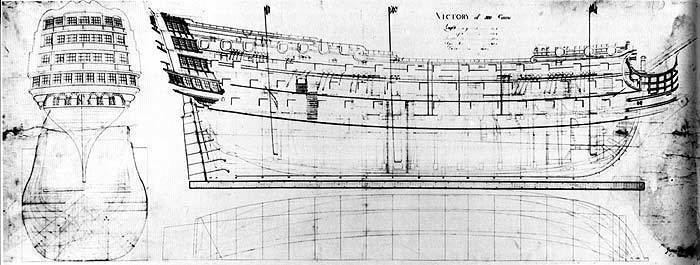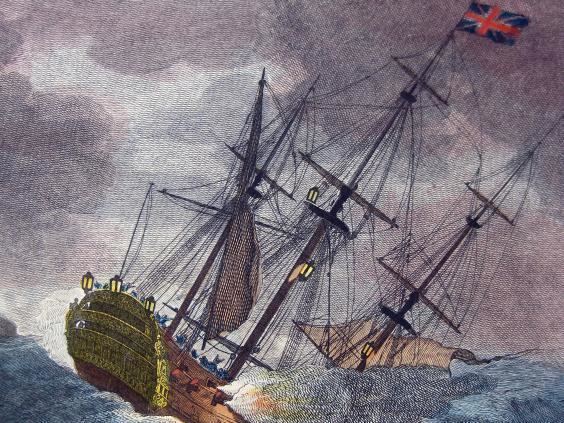Name HMS Victory Laid down 1726 Construction started 1726 Length 53 m Beam 15 m | Ordered 11 September 1733 Tons burthen 1921 bm Launched 23 February 1737 Draft 5.5 m Builder HMNB Portsmouth | |
 | ||
Fate Wrecked, 4/5 October 1744 Class and type 1733 proposals 100-gun first rate ship of the line | ||
HMS Victory was a 100-gun first-rate ship of the line of the Royal Navy, built to the dimensions of the 1733 proposals of the 1719 Establishment at Portsmouth Dockyard, and launched on 23 February 1737.
Contents

Construction

A small number of the timbers used in the construction of Victory were taken from the remains of the previous HMS Victory, which had caught fire and been burnt to the waterline in February 1721 whilst having weed burned from her bottom (in a process called "breaming"). Officially a rebuild of the previous vessel, the new Victory was built by master shipwright Joseph Allin and cost £38,239 to assemble, plus £12,652 fitting as a flagship. Launched in 1737 she became the flagship of the Channel Fleet under Sir John Norris following completion in 1740. She was the last British First Rate to be armed entirely with bronze cannon.

The Victory was "a high-sided ship for her draught and this was believed to have made her leewardly and to have led to her loss". The term "leewardly" means she had a tendency to be pushed to leeward (down wind) more than normal when sailing with the wind on a quarter or on the beam, making her hard to keep on course. A plan of the ship reproduced in Howard and an extant contemporary model also show her with four rows of lights (stern galleries) and three quarter galleries, one more of each than was usual for an English three-decker in any period.
Loss of Victory

She was wrecked with the loss of her entire crew while returning to England as the flagship of Admiral Sir John Balchen after relieving Sir Charles Hardy, who had been blockaded in the Tagus estuary by the French Brest fleet. As the fleet reached the English Channel on 3 October 1744 it was scattered by a large storm. At around 15:30 on 4 October, the ships accompanying Victory lost sight of her near the Channel Islands. For over 260 years she was believed to have been wrecked during the night on Black Rock just off the Casquets, with the loss of her entire complement.

Frigates were dispatched across the English Channel to search for her where she had last been seen wallowing on the horizon on 4 October. Eventually, Captain Thomas Grenville of HMS Falkland landed at Guernsey in the Channel Islands to provision, and there heard from locals that wreckage and part of a topmast had washed up on the island's shores. Further investigation proved that the wreckage had indeed come from Victory, which was believed to have run into the Casquets, a group of rocks nearby. Other wreckage was washed up on Jersey and Alderney, whose inhabitants had heard distress guns the night before the wreck but were unable to provide aid in the severe storm. No trace of any of the 1,150 sailors aboard Victory was found until the wreck was discovered in 2008.
Finding of wreck

On 1 February 2009, the Associated Press reported that Odyssey Marine Exploration, based in Tampa, Florida, United States, claimed to have found the wreck in May 2008, and has recovered two of the one hundred bronze cannons. Located in the Western Approaches between England and France, as a military wreck she legally remains the property of the British Government under the laws of marine salvage. The wreck was found "more than 80 km (43 nm) from where anybody would have thought it went down", according to Odyssey Marine Exploration CEO Gregg Stemm, and 100 m (330 ft) deep, meaning that the vessel had not foundered on the Casquets as had been surmised, but lay approximately at latitude 49°42.5' N and longitude 3°33.3' W. The team announced their findings publicly on 2 February and stated that they were negotiating with the British government over the wreckage. On 26 March 2009, the TV show Treasure Quest, which had followed the company's ship Odyssey Explorer exploring several different shipwreck sites, aired two hours of footage of the Odyssey Explorer's initial findings of the ship. The show included footage of the Odyssey Explorer's crew finding a 42 pounder cannon that initially essentially identified the wreck as the Victory. The crew raised a 42 pounder cannon and a 12 pounder cannon.
In January 2012 it was reported that the remains of HMS Victory are to be raised from the sea bed. The wreck is to be handed over to the Maritime Heritage Foundation, which is expected to employ Odyssey Marine Exploration to carry out the recovery. The terms of the contract with Odyssey Marine Exploration remain controversial, with concerns over, "allowing foreign investors to profit from the property, grave and memorial of Royal Navy personnel".
